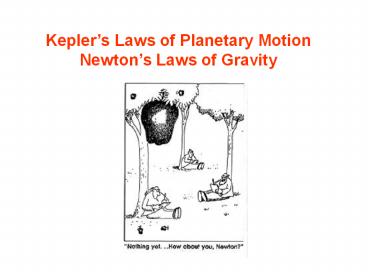Kepler - PowerPoint PPT Presentation
Title:
Kepler
Description:
At each point in the orbit, the mass (m) is the same... no effect. 1. As distance (r) increases... Mass 1 Mass 2 Distance d2 Fg. 1 1 1 1 (1)(1)/(1) = 1. 2 1 ... – PowerPoint PPT presentation
Number of Views:1269
Avg rating:3.0/5.0
Title: Kepler
1
Keplers Laws of Planetary Motion Newtons Laws
of Gravity
2
PLANETARY MOTION --- what kind of curves do
planets follow in their orbits? Two obvious
closed ovals the circle and the ellipse
eccentricity increasing
circle eccentricity0
ellipse eccentricity 0ltelt1
3
Keplers 1st Law Planets orbit in ellipses
with the Sun at one focus.
(closest approach)
(farthest extent)
4
Keplers 2nd Law A line from a planet to the
sun sweeps out equal areas in equal times.
5
Keplers 2nd Law is a consequence of conservation
of angular momentum
6
sweep m r v
2
1
sweep m r v
At each point in the orbit, the mass (m) is the
same no effect 1. As distance (r) increases
velocity (v) decreases in proportion 2. As
distance (r) decreases velocity (v) increases
in proportion
7
ORBITAL MOTION --- why do planets orbit on
ellipses? ---
why does any object regardless of composition
fall? --- why
do objects sometimes orbit, or sometimes fall?
8
NEWTONs LAW OF GRAVITY (Universal Attraction)
Consider two masses, M1 and M2, separated by a
distance d
The FORCE of attraction, called GRAVITY, is Fg,
given by the above.
9
M1M2
Fg G ---------
d2
Mass 1 Mass 2 Distance
d2 Fg ----------
---------- ------------ ---------
--------------------- 1
1 1 1
(1)(1)/(1) 1
2 1
1 1 (2)(1)/(1) 2
1 2
1 1 (1)(2)/(1) 2
1 1
2 4 (1)(1)/(4) 1/4
2 2
1 1 (2)(2)/(1) 4
2 2
2 4 (2)(2)/(4) 1
1 2
1/2 1/4 (1)(2)/(1/4) 8
10
If Gravity turned off magically, the planets
would move off in straight paths, where the
direction depends upon the instantaneous velocity
Fg
This behavior is Netwons 1st Law of Motion A
body continues in uniform motion (straight line
constant speed) unless A force is acting upon it.
11
So WHAT IS AN ORBIT?
12
So WHAT IS MASS?































